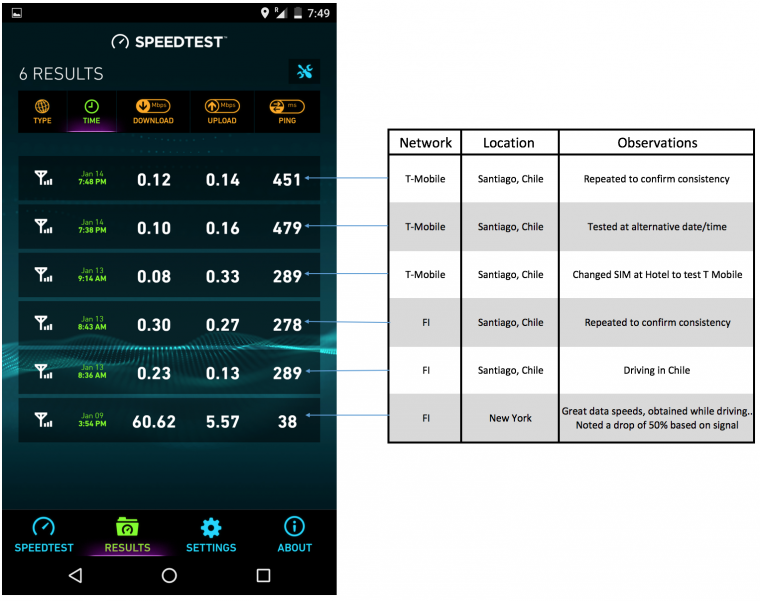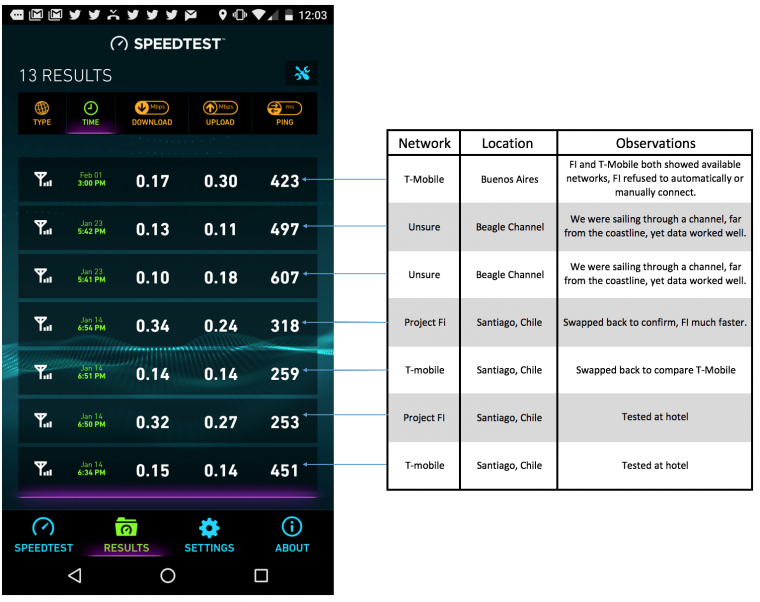I wrote some time ago about the two services offered by Google (Project Fi) and T Mobile, with a particular interest on the travel applications. Both services offer some great things to travelers, but the argument on which was actually better remains anecdotal.
Here’s a background post on this for you who missed it. In that post I felt that Fi was superior to T mobile, primarily due to International Data speed. Fi appeared, on paper, to operate at twice the speed of T Mobile. Having bought a Nexus 5x from Project Fi for my trip around South America, Vinh from MilesPerDay offered to send me a Sim from T Mobile that he had, and so I embarked on a journey not only to see some of the most amazing places on earth, but to also see how the two services compared.
Executive Summary
T Mobile performed consistently throughout the trip. It worked in every location visited other than the Falkland Islands. The data speeds were around 0.13 Mbps up and down. Project FI worked at about double those speeds, reaching into the 0.30 Mbps range. While both are slow compared to the 4G LTE speeds we are used to, the difference between 0.13 and 0.30 is noticeable.
I had thought that Project Fi was the clear winner, until it started behaving in an unusual manner, refusing to connect to networks in 3 of the 5 Countries that we visited. When it did connect, speeds were 2-3x faster than T Mobile.
Countries/Territories Visited
- Chile (multiple cities) both connected without issue. Speeds 2-3x faster on Fi.
- Argentina (multiple cities) Fi would not connect in Argentina at all, over a period of a week in three different cities. T Mobile connected everywhere, offering consistent speeds.
- Falkland Islands – neither phone would connect here (nor would a roaming ATT iPhone 6)
- Uruguay Fi would not connect in Uruguay, T Mobile was consistent.
- Brazil- Both connected without issue. Speeds 2-3x faster on Fi.
Additionally, we got a signal when sailing through the Beagle channel, which was pretty impressive, I believe it was through Project Fi, but am not totally certain as my mental notes aren’t what they used to be.
Here’s some screenshots of the data speed


I did try to work with Project Fi to get the connection issue resolved. They recommended attempts to manually connect to networks/reboots/etc. I also sent through bug reports. Nothing helped.
It was a little frustrating, because Fi would tell me that 3 local networks were available, but simply refused to connect, yet when I swapped out the Sim to T Mobile it would hook in straight away, and provide consistent service.
Other notable differences and concerns
Project Fi handles data usage differently from T Mobile. With T Mobile you get unlimited data (albeit at slower speeds) with Fi, you pay per Gb used. However, Fi is a little weird in how it bills.
With Fi you estimate your usage needs. For example, I picked 2GB data, for $20, on top of the $20 per month line charge. Here’s how it works on my bill:
January
- $20 line
- $20 Estimated 2 GB data
- tax.. total $45
February
- $20 Line
- $20 Estimated 2 GB data
- -$15.78 (1.578GB of data from Jan wasn’t used and rebated)
- $0.09 Call (3 cents per minute Chile to Chile local call)
- $4.28 International Data
- tax etc
As such, Fi International Data is charged at the same rate as domestic US data, but is charged separately.. it all comes out in the wash, but is just weird.
On a more serious (and weird) note
Calling with Fi is a powder keg. From above, I called a guy in Chile on his cell to arrange a car rental. The charge was 3 cents per minute, which is fantastic. However, each carrier with Fi has a price agreement in place, and that means that you could call a local phone like I did, to arrange a car or tour, and be charged a huge amount of money for it.
If you were to call Switzerland to confirm your vacation details, depending on the carrier that you use you could be charged up to $2.50 per minute for that. For a full rate table check here. If you used Google Hangouts to call you’d be notified of the price, but on Project Fi you’d only know when you get the bill. Note that it says the rates are for calling TO these countries from the US, I wouldn’t be surprised if you get charged the same within the country. The reality is that Project Fi is younger, and doesn’t have the cross border agreements resolved in the manner that other telecom carriers have. That doesn’t mean that they couldn’t grow into something spectacular, but for now, they remain a project.
Personally, I have kept my Project Fi phone despite the inferior performance against T Mobile as we have another multi country trip coming up soon, and I think it might be useful to give it a bit more of a run. I’m not sure I’ll test it against T Mobile again for that trip as the swapping of SIMs is annoying.
Overall the most important lesson I took from the experiment is that on paper Project Fi looks better, but sometimes it’s best to actually do a side by side evaluation in the real world when making such decisions. Faster data that doesn’t connect isn’t very fast at all.
Thanks Matt! This is super helpful. I am with Project Fi for now and hopefully they will improve their international service. One thing that I don’t like about Fi’s billing is that you pay taxes regardless of the amount of data you use. For example, say they tax me for 4 dollars for 1 GB’s data. If I only used 100 MBs, they will only refund $9 of data fee, but will not refund the prorated taxes that I paid. I know this sounds a bit crazy but again with other MVNOs we don’t pay taxes at all (I was with H2O before).
Were you able to use Project Fi to tether to your laptop? I called two different reps at PF and none could give me a straight answer as to whether this was possible. W / TMO you cant tether internationally, which would be huge, but even more so if on a cruise ship.
Were you able to use Project Fi to tether to your laptop? I called two different reps at PF and none could give me a straight answer as to whether this was possible. W / TMO you cant tether internationally. This would be huge, but even more so if on a cruise ship.
I didn’t tether but it seems to work fine: https://support.google.com/fi/answer/6182204?hl=en
Thanks Matt! This is helpful. I always use T-mobile MVNO internationally and it is great. Like you, I thought that Fi is better “on paper” but not in reality.
FWIW, I tethered my Chromebook to Project FI and it worked great. This was in Tulum.
I have just dropped TMobile to go with Fi…this is after years of using TMO in Europe, South America, and Asia. I primarily use texts and data…and I was always disappointed in data speed with TMO…going to spend 6 weeks between Australia and New Zealand starting in May…hopefully Fi is as good as some of the reports…thanks for the article and follow up…
Hi Matt: I believe the rate to make calls on FI in Switzerland is 20 cents….not the $2.50 that you indicated may be the same as from calling from the U.S…
Have you called them in Switzerland or just reading that?
20 cents is the published rate and while I haven’t used them in Switzerland, I have used them in other countries to call locally where the rate is different then the rate to call from the US and haven’t had a problem not getting 20 cents rate.
Sounds good. Thanks for the datapoint.
Just got back from using TMO in Italy and Germany. TMO was great. After turning on my phone upon landing in each country I had no service. I had just enough time to utter a three letter curse , could not complete the fourth letter and a text arrived welcoming to the network.
Users shoud realize that if connected to WIFI and the phone is able to do wifi calling calls to the USA might be free.
I had a problem with Fi connecting the first time I tried to use it overseas. Customer service recommended that I clear the cache and data in the Project Fi app., turn airplane mode on/off and restart the phone.
Yeah I did all that.. Didn’t work. Did it work for you?
Pricing calls by operator in the destination country has long been typical for phone cards, VOIP, etc. – looks like it’s continuing here because the wifi calling on Fi is a rebrand of Hangouts, which was a rebrand of Google Voice international service. I’ve used that quite a bit over time, and it does announce the rate you’re to be charged before it connects the call – I suppose a workaround would be to listen for that, and if it’s extreme, hang up, flip off wifi, and then redial the call so that it uses the cell network and is guaranteed to be billed at 20c/min. Inconvenient, but not clear how often those extreme rates will pop up.
The inconvenience is a big factor though as it requires mental real estate…
Project Fi has been working great in Sydney Australia…I have been on LTE 95% of the time in the city…next test is the south island in New Zealand…followed by Melbourne and Cairns in Australia…I switched from TMO before this trip…and I am very pleased that I did so…
Good stuff. I’ve found when it works it’s far superior… It’s just that when it doesn’t 🙂